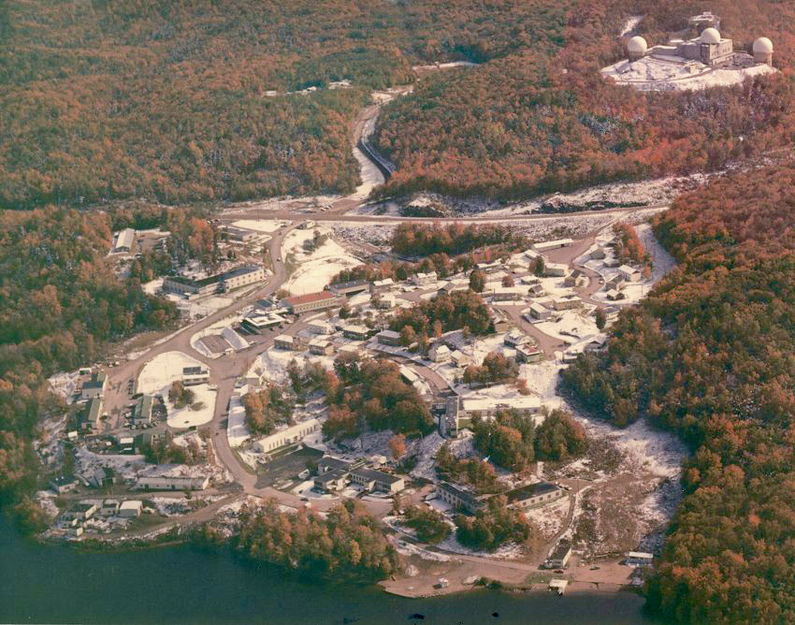RCAF Station Lac St. Denis
|
RCAF Station Lac St. Denis (1952-1986) - A Cold War RCAF Pinetree Line Radar Station established during the Korean War. Located near Morin Heights, Quebec, Canada. Initially assigned a Permanent ID of C-2 and a Sage ID of C-2. Originally named RCAF Station Lac St. Denis. After unification, it was renamed CFS Lac St. Denis. Closed in 1986.
HistoryEstablished in April 1952 and became operational on 1 Jul 1952 as RCAF Station Lac St. Denis manned by the No. 11 Aircraft Control and Warning Squadron. Initial equipment included a CPS-6B search/height finder radar and a second CPS-6B as a backup if the active CPS-6B had a problem with either function. Manual System OperationIn April 1952, the No. 11 Aircraft Control and Warning Squadron (AC&W) moved to Lac St. Denis and on 1 Jul 1952, it became fully operational as a Ground Control Intercept (GCI) radar site. On 1 Nov 1952, No. 1 Air Defence Control Centre (ADCC) was also formed at Lac St. Denis and remained there until its disbandment as Montreal NORAD Sector on 15 Sep 1962. The No. 11 AC&W Squadron reported to the colocated No. 1 ADCC (as did other squadrons as they came online). Operations continued in the manual mode until the SAGE annex at Lac St. Denis was completed and the new SAGE equipment (FST-2) was installed and checked out. The SAGE building construction commenced in May 1961 and was completed on 31 Mar 1962. By September 1963 the FST-2 was installed and testing was complete with the FST-2 connected to the Topsham SAGE Direction Center DC-05, Bangor Air Defense Sector. Closure of the No. 1 ADCC was the direct result of the SAGE activation and that caused a dramatic reduction in personnel. Most of the 1 ADCC personnel were women and all the female positions were eliminated in September 1962. On 1 Sep 1962, there were 126 women in place and by the 15th they had all departed. Prior to leaving, they held a parade, and they presented the Station with a bronze plaque marking their service to be mounted at the entrance of the Station. SAGE System TransitionThe transition of the manual GCI system to the automated SAGE system began with the installation of the FST-2 coordinate data transmitter and search radar upgrades. The FST-2 equipment digitized the radar returns and transmitted the digital returns to the SAGE direction center. Under the SAGE System, interceptor aircraft were directed to their targets by the direction center computers and controllers, greatly reducing the need for local controllers and equipment at every radar station. The FST-2 was a very large digital system using vacuum tube technology. Over 6900 vacuum tubes were used in each FST-2 requiring 21 air-conditioned cabinets, 40 tons of air conditioning, 43.5 kva of prime power, and usually a large new addition to the operations building. The FST-2B modification added two more cabinets but with newer solid-state (transistor) technology to process coded responses from aircraft transponders. SAGE System Operation
The site began operation as a SAGE site on 15 Sep 1962 initially feeding the Topsham SAGE Direction Center DC-05. On 15 Sep 1962, the squadron designation was changed from the No. 11 Aircraft Control and Warning Squadron (AC&W) to No. 11 Radar Squadron (SAGE) indicating the new SAGE System role. The connection to Topsham Direction Center probably lasted thru an extended operational test period until the North Bay Direction Center was ready to connect. In September 1963 the North Bay direction Center begin live operation. ClosureCFS Lac St. Denis AFS and the No. 11 Aircraft Control and Warning Squadron ceased radar operations in December 1985 and the site closed on 1 Aug 1986 Gap FillersCFS Lac St. Denis AFS was responsible for the maintenance of one remote unattended gap-filler radar site. The unattended gap filler sites were placed in locations where the main search radar lacked coverage. These sites were equipped with short range FPS-14 or FPS-18 search radars and FST-1 Coordinate Data transmitters that sent digitized radar target data to a SAGE direction center and to the main radar site. Both the radar set and the FST-1 were dual channel to increase site up time. Maintenance teams were dispatched for regularly scheduled maintenance or when fault indicators on the FSW-1 remote monitoring equipment suggested the site had problems. The FSW-1 also allowed remote operation of specific functions such as channel changes for the radar and for the FST-1, it also allowed remote operation of the diesel generators at the gap filler site. The CFS Lac St. Denis gap-filler radar was located at Lac Ste. Marie.
Physical PlantThe physical plant of the site was divided into the main site, a cantonment area, a housing area, and a radio site. The main site housed the operations buildings, the radar towers, and the backup generators. The cantonment area housed the enlisted barracks, the bachelor officer's quarters, the orderly room, the dining hall, the motor pool, and other support buildings. Apart from the main site was a housing area for married personnel. A separate radio site housed the radio equipment for directing aircraft intercepts. Like most early radar stations, CFS Lac St. Denis originally had a radio transmitter site and a separate radio receiver site used by local controllers for voice direction of fighter interceptors to their targets. With the SAGE System, the SAGE Direction centers had the primary task of directing intercepts and the local radio sites were reconfigured, usually into a single site that was known as the Ground to Air Transmitter Receiver (GATR) site. The GATR site communicated with the interceptors from either the local site or the SAGE direction center via voice commands and/or a digital data link.
Current Status
See Also:
Sources: Links:
Visited: No
| |||||||||||||||||||||||||||||||||||||||||||||||||||||||||||||||
